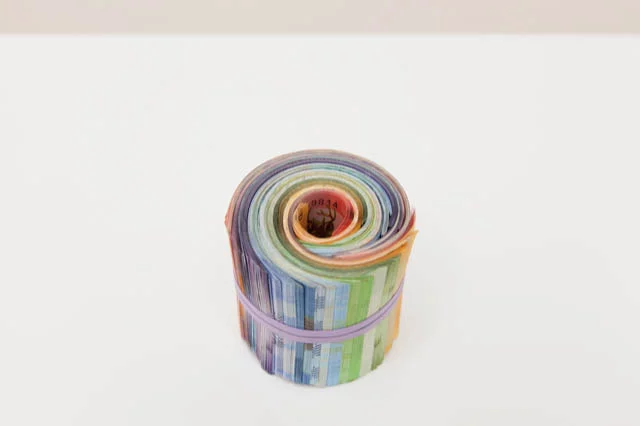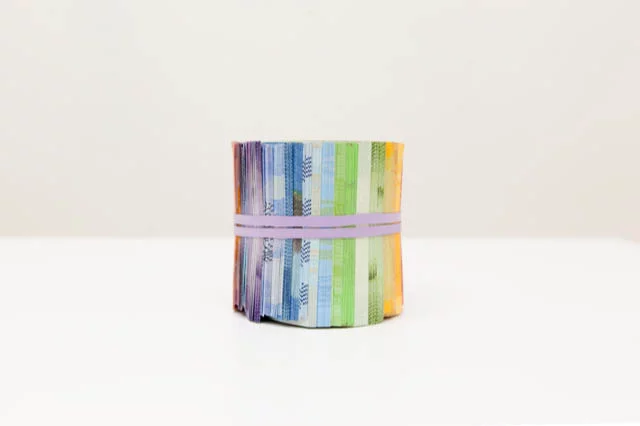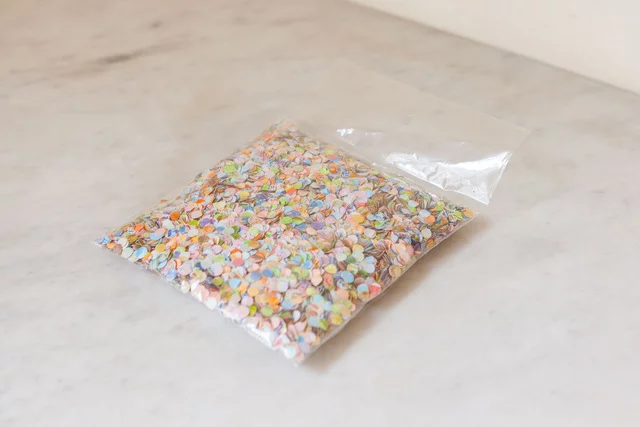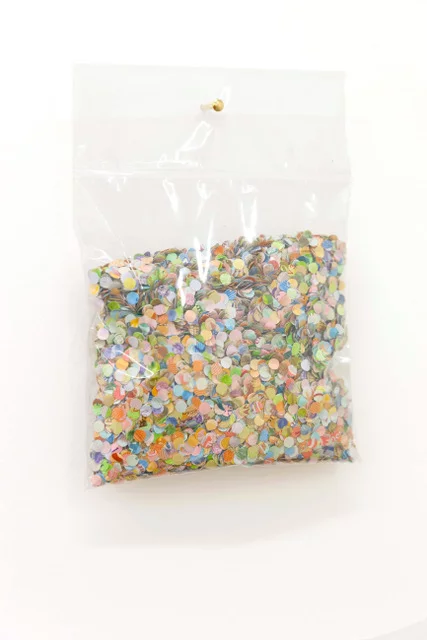Facebook
Twitter
WhatsApp
Adriana Martínez Barón was born in 1988 in Colombia and lives and works in Bogotá. Her perspective on globalization is shaped by the disproportionate share of exploitation her country has suffered, turning matters of labor and production into ones of visceral emotion. Her installations turn the materials generated by these enterprises back upon themselves. By displaying consumer items and icons in overwhelming numbers and transforming items of consumption and waste into avatars for global capital, the artist contends with physical and mental pollution of trade cycles spinning at an increasingly frantic pace.
Martínez Barón infuses items from daily life with political significance, forcing a reexamination of consumer culture and its long-range global impact on those who can least withstand it. In Momentos que duran para siempre (2021), a cardboard shipping box is upturned on the floor, vomiting out mass-produced treats. Tutti Frutti (2017) is a makeshift fruit stand featuring mangos, bananas, and coconuts emblazoned with dozens of manufacturer’s stickers, forcing a queasy confrontation with the abusive relationship between multinational produce conglomerates and their workers. While Martínez Barón’s subjects are serious and imbued with a sense of urgency, the artist’s methods and materials remain buoyant, colorful, and inclusive. Al final del arcoiris (2015) is a festive roll of rainbow-colored currency, a work that is both irrefutably cheerful and canny in its commentary on transaction and how global needs fuel local industries, both legitimate and illicit. The artist expands upon the classic artistic trope of readymades; indeed, her work rarely fits into the confining distinctions of fine art and often blends mirth and whimsy with acerbic cultural critique.
More recent works adapt common products and experiences from the COVID-19 pandemic into incisive commentary on capitalism’s corrosive influence. To make Mercado del arte (2020), the artist collaborated on an interactive platform that allowed artists to display and distribute their “products” in person and online. Martínez Barón explains: “Our city, Bogotá, had one of the strictest quarantines in the world, and people were scared to go to art shows, so our show took the shape and dynamics of a supermarket, which was a place people felt safe.” In Sealed Air (2021), plastic packing bubbles are placed inside a commercial refrigerator. “The companies that sell sealed air increased their fortune after COVID-19 due to the high demand for food delivery services that, in general terms, help increase global warming. Packed air may seem absurd and surreal, but in a globalized world it is becoming the norm.” In a nod to Marcel Duchamp’s “Rrose Selavy,” the artist’s very name is a creation, a more marketable identity to accompany her work. Born Adriana Martínez, the artist found that it was hard for people to find her online, as there were several artists with the same name. She adopted “Martínez Barón” to become more unique from an SEO standpoint. This choice is an indicator that rejecting global forces and trends is not always the most subversive option. The work will continue to spread around the world and shake our understanding of the dark forces behind supposedly benign spaces of commerce.


Adriana Martínez Barón
At the End of the Rainbow
2023
Banknotes and rubber band
7 × 7 × 7 cm


Adriana Martínez Barón
Latin Tears
2020
Punched-out banknotes and plastic bag
Dimensions variable
Adriana Martínez Barón was born in 1988 in Colombia and lives and works in Bogotá. Her perspective on globalization is shaped by the disproportionate share of exploitation her country has suffered, turning matters of labor and production into ones of visceral emotion. Her installations turn the materials generated by these enterprises back upon themselves. By displaying consumer items and icons in overwhelming numbers and transforming items of consumption and waste into avatars for global capital, the artist contends with physical and mental pollution of trade cycles spinning at an increasingly frantic pace.
Martínez Barón infuses items from daily life with political significance, forcing a reexamination of consumer culture and its long-range global impact on those who can least withstand it. In Momentos que duran para siempre (2021), a cardboard shipping box is upturned on the floor, vomiting out mass-produced treats. Tutti Frutti (2017) is a makeshift fruit stand featuring mangos, bananas, and coconuts emblazoned with dozens of manufacturer’s stickers, forcing a queasy confrontation with the abusive relationship between multinational produce conglomerates and their workers. While Martínez Barón’s subjects are serious and imbued with a sense of urgency, the artist’s methods and materials remain buoyant, colorful, and inclusive. Al final del arcoiris (2015) is a festive roll of rainbow-colored currency, a work that is both irrefutably cheerful and canny in its commentary on transaction and how global needs fuel local industries, both legitimate and illicit. The artist expands upon the classic artistic trope of readymades; indeed, her work rarely fits into the confining distinctions of fine art and often blends mirth and whimsy with acerbic cultural critique.
More recent works adapt common products and experiences from the COVID-19 pandemic into incisive commentary on capitalism’s corrosive influence. To make Mercado del arte (2020), the artist collaborated on an interactive platform that allowed artists to display and distribute their “products” in person and online. Martínez Barón explains: “Our city, Bogotá, had one of the strictest quarantines in the world, and people were scared to go to art shows, so our show took the shape and dynamics of a supermarket, which was a place people felt safe.” In Sealed Air (2021), plastic packing bubbles are placed inside a commercial refrigerator. “The companies that sell sealed air increased their fortune after COVID-19 due to the high demand for food delivery services that, in general terms, help increase global warming. Packed air may seem absurd and surreal, but in a globalized world it is becoming the norm.” In a nod to Marcel Duchamp’s “Rrose Selavy,” the artist’s very name is a creation, a more marketable identity to accompany her work. Born Adriana Martínez, the artist found that it was hard for people to find her online, as there were several artists with the same name. She adopted “Martínez Barón” to become more unique from an SEO standpoint. This choice is an indicator that rejecting global forces and trends is not always the most subversive option. The work will continue to spread around the world and shake our understanding of the dark forces behind supposedly benign spaces of commerce.


Adriana Martínez Barón
At the End of the Rainbow
2023
Banknotes and rubber band
7 × 7 × 7 cm


Adriana Martínez Barón
Latin Tears
2020
Punched-out banknotes and plastic bag
Dimensions variable